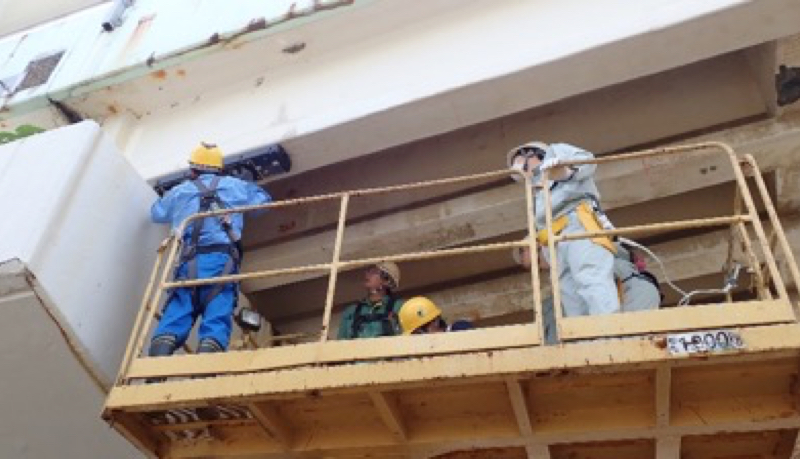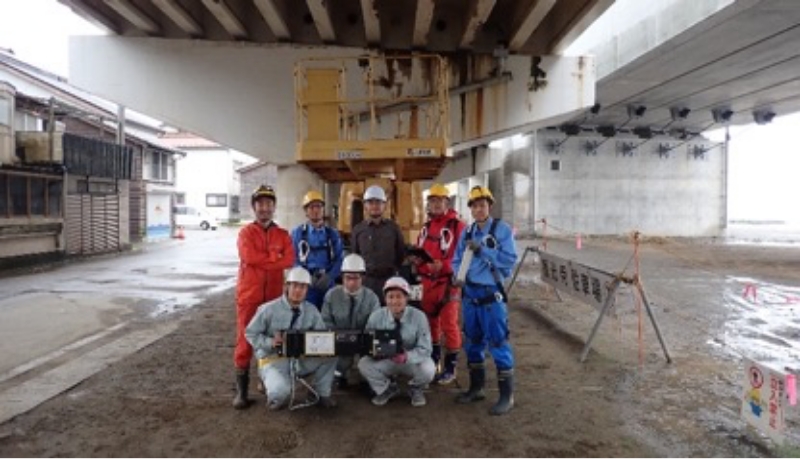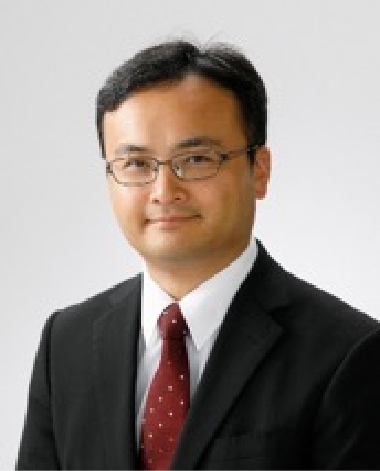Case and interview
Highly accurate and practical SenrigaN, “completely different” to previous magnetic measurement
What is most important for estimating bridge strength is understanding the rupture state of the tendons
Professor Tanaka's laboratory is developing technology using information and computing technology (ICT) to check the strength and durability of civil engineering structures (bridges, tunnels, etc.). With the aim of providing civil engineering structures that are resilient and lasting in the face of disasters, he is researching a speciality evaluation of the health of deteriorated structures, such as combining non-destructive measurement and structural analysis to calculate bridge life.
“Estimates of the strength of concrete bridges are determined comprehensively from various pieces of information, but what is most important is the rupture state of the tendons. Until now, the only way was to make holes in several locations to check and estimate the state of deterioration of the entire tendons. Because strength determinations that people’s life depends on, such as whether this bridge is safe to cross or whether it must be closed to traffic immediately, are made based on the tendon rupture state, I really wanted to check the entire tendons. For that reason, I have been looking for a method that would let me test the deterioration state of the tendons non-destructively.”
I believe that the accuracy of SenrigaN’s rupture determinations has passed a certain mark.
› What was the trigger for finding out about SenrigaN?
It was an introduction from Professor Shimomura of the Nagaoka University of Technology. The trigger was when he told me that there seems to be a new non-destructive testing device. There have been non-destructive testing devices before. However, (when we tried them on the Myōkō Bridge,) their accuracy only found about one location in ten, so I had the impression that they were unusable, and I tried it with the skeptical view that it would probably be no good again. (The location was the Benten Bridge. Because the timing was when the Hokuriku Regional Development Bureau started the Bridge Salt Damage Survey, we decided to try it out there.)
› How were the results from testing it?
Contrary to my prediction, the device was correct in nine of the ten locations it was determined to be ruptured, and a foreign body was confirmed at the other location, too.
The key point with SenrigaN is that it has more information than the earlier non-destructive testing devices. Because 540 sensors acquire data along the three X-, Y- and Z-axes in planes, foreign bodies, tendons in different positions to the plans, and various other states are readily visible by comparisons with the surrounding states, and it is markedly easier to determine whether there is an abnormality or not. I got the impression that it was “completely different to everything until now.” What is most important for determining ruptures is accuracy. In this regard, I believe that SenrigaN has passed a certain mark.

The operability is also much better. In previous devices, the magnet necessary for measuring was too heavy, and was such a burden that even young university students got so tired that they could not lift their arms partway through. But SenrigaN has been made compact so that students can measure six beams in a day and a half, and I got the impression that it has become more usable in terms of physical strength as well.
I found that reading the data that is obtained takes some getting used to. I also mastered it only recently. Once you have been explained the principles, it is easy to understand, so receiving training at first is important. In future, it should be necessary to have analysis methods that are easy for people unfamiliar with the device to understand, and I intend to research them as well.
The reliability of safety and security in bridge maintenance will change.
› How was it compared to other methods?
Essentially, when testing the deterioration state of internal tendons, you want to measure the whole surface if possible. This is because the location 50 centimeters away can be in a completely different state. However, until now, the only way was to infer the entirety from partial testing by shaving, endoscopy, X-rays, or other techniques. Destructive testing creates worries about the strength of the bridge after that, and X-ray testing also takes time to set up and ensure safety, so that measuring three surfaces in one day costs tens of millions of yen; in this way, each technique has its own issues.

What is more, the reality is that conventional testing instruments for the flux leakage method work fine in the laboratory, but judgments are difficult on actual bridges. Compared to these methods, SenrigaN is highly practical. If non-destructive testing reaches a practical level, we will be able to gain accurate information about everything. If we know about the state of ruptures accurately, the methods for computing the bridge strength are already established. In this way, the reliability of safety and security in bridge maintenance will change.
› Tell us about your outlook for the future.
In post-tensioned bridges in particular, which have a risk of internal deterioration progressing even without any external abnormalities, it would be ideal if the bridges could be checked with SenrigaN once a certain number of years elapses, in the same way that people have a health checkup once they reach a certain age. In addition, I hope that if the testing speed increases further, it could be introduced as a matter of course in repair design for sections with external abnormalities. Improvements in the accuracy of repair design will fill the gap with the actual construction and lead to more accurate repair works.


